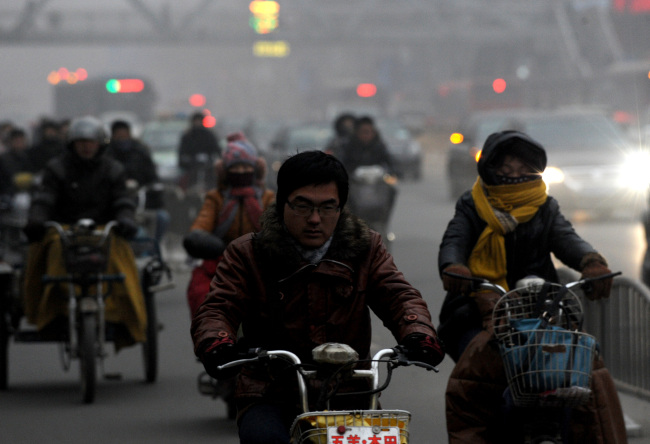 |
Citizens ride motorcycles amid heavy fog in Zhengzhou City, China. (Xinhua-Yonhap News) |
The city of Beijing proposed rules that would shut down factories and take cars off the road when smog reaches dangerous levels, as officials stepped up efforts to address pollution that reached record levels this month.
Under the new rules, drivers could face 3,000 yuan ($482) in fines if their vehicles exceed emissions limits, while the construction of new cement and steel plants would be outlawed. A draft was posted on the Beijing government’s website Jan. 19 and the public will have until Feb. 8 to comment.
The stricter anti-smog efforts appeared a week after pollution levels in the city hit a level that was almost 40 times recommended World Health Organization limits. State-run media expressed skepticism that the new rules would have much effect, underscoring the challenges the government faces in tackling pollution.
“New regulations intended to kick in when pollution in Beijing reaches extreme levels will likely be as ineffective as the previous law,” the Global Times said in an article Monday, citing environmental experts in the city.
Official measurements of PM2.5, fine airborne particulates that pose the greatest health risks, rose as high as 993 micrograms per cubic meter on Jan. 12, a record high, according to the Institute of Public and Environmental Affairs. The World Health Organization recommends 24-hour exposure to PM2.5 levels no higher than 25.
After pollution levels fell during the week, smog rose again over the weekend and children and the elderly were advised to stay indoors as the air became “heavily polluted,” according to Beijing Municipal Environmental Monitoring Center classifications.
Air quality in Beijing improved Sunday after snowfall slowed the accumulation of pollutants, and will remain “relatively good” for the next couple of days, the city’s environment monitoring center said on its official Weibo microblog on Sina.com.
Levels of PM2.5 levels hit 155 at 9 a.m. near Tiananmen Square, according to government readings. The U.S. Embassy’s pollution monitor said PM2.5 levels were 198, or “unhealthy.”
The draft regulation proposed that construction sites and transportation operators should take measures to control the release of particulates.
Long-term exposure to fine particulates raises the risk of cardiovascular and respiratory diseases as well as lung cancer, according to the WHO. The official English-language China Daily newspaper said Jan. 14 that Beijing was becoming better known for “Beijing Cough” than it was for Peking Duck or Peking Opera.
China, which the World Bank estimates has 16 of the world’s 20 most-polluted cities, is the largest emitter of greenhouse gases. The burning of coal is the main source of pollution, accounting for 19 percent, while vehicle emissions contribute 6 percent, according to a study by Greenpeace and Peking University’s School of Public Health published Dec. 18.
Li Keqiang, set to become China’s next premier, called for the nation’s citizens to be patient as authorities work to reduce pollution. (Bloomberg)








